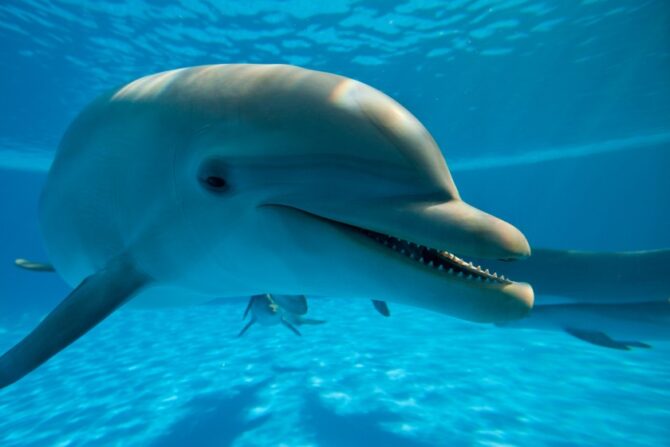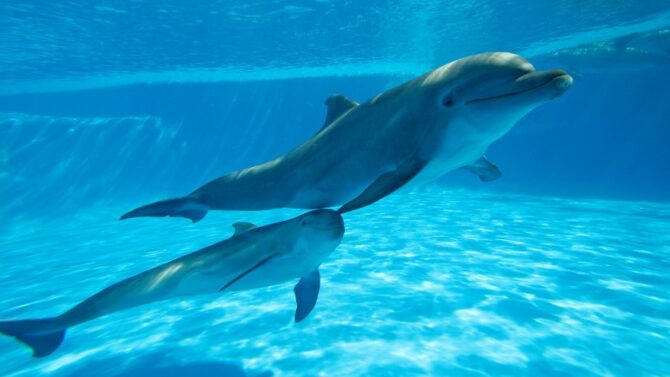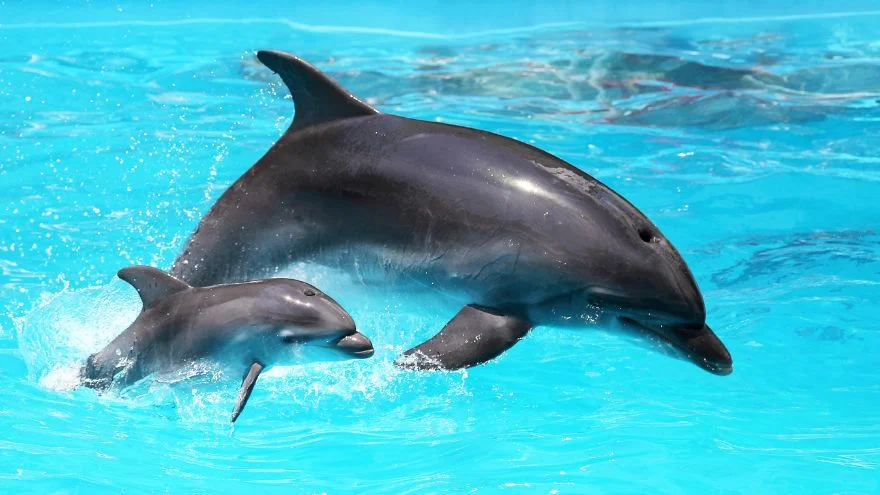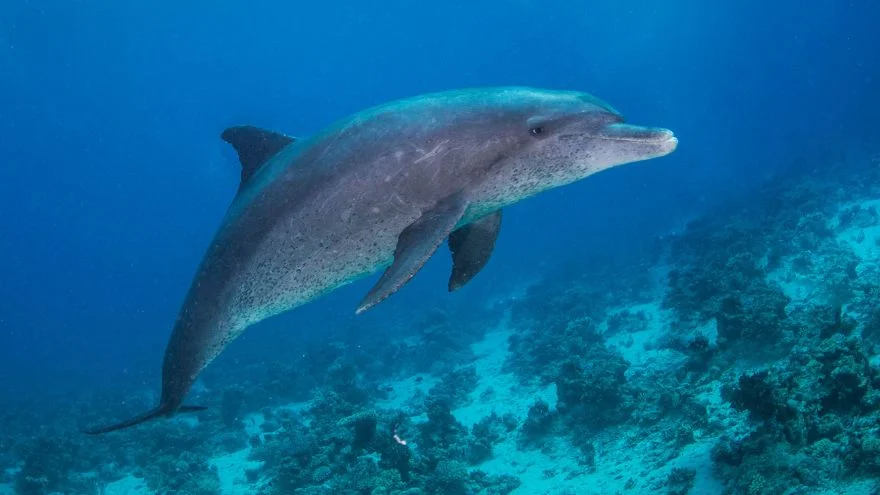Being cheerful with a lovable disposition makes dolphins seem like an odd fit in the perilous and rogue world of underwater living, and thus you may wonder what do dolphins eat?
This is a valid question considering that these underwater creatures do not pass for brutal and ferocious predators that almost assures enough chow in the extremely competitive world of aquatic living.
Logically, most people give the same reply to the question, “What do dolphins eat?” — fish. Nevertheless, dolphins have a list of food options on their menu. What are these options, and how do they get their food?
We will answer these questions and other facts in this article.
A Closer Look At Dolphin Diet And Food Chain
Without a doubt, fish exist in abundance in all the different waters one may find dolphins; this proposition may logically infer that dolphins eat fish.
While the assertion is far from wrong, dolphins are opportunistic feeders that consume what is readily available in their habitat.
As such, the dolphin world contains carnivorous members with distinctive diet choices and feeding habits.
Food preferences also exist between species since size and location are determining factors. Sadly, dolphins are not atop their food chain, succumbing to large sharks’ ferocious hunting skills and assorted food choices.
What Do Dolphins Eat?

Dolphin food choices vary by species, but generally, they consume a piscivorous diet of fish, squid, and other small marine animals.
The dolphin family contains thirty-six known members of carnivorous taxonomic species with a diet mostly of fish. However, other items on their menu are crustaceans, lobsters, crabs, squids, shrimp, and jellyfish.
Most dolphin species enjoy hake, eels, mullet fish, and other fish species, even though some larger species, like the orca, may consume larger marine life, including sharks and seals.
A general list of dolphin diets includes cod, croaker fish, pilchards, anchovies, carp, and goby fish, alongside the species mentioned earlier.
Human pollution has affected dolphins’ diets with inedible objects like plastic bags and tin cans, forcing the friendly mammal to consider these options when they cannot find food.
How Dolphins Hunt for Prey?
One thing that makes dolphins fascinating is their intelligence level, evidenced by their hunting methods.
Most dolphins find their food with a technique called echolocation, using sound waves reflected by the prey.
These marine mammals make clicking noises that show them possible fish locations.
Dolphins may hunt alone or in pods (a group of dolphins). However, finding a school of fish with echolocation is just a step to feeding.
Social species will need to employ division of labor, teamwork, role specialization, and trickery to get their feast, which differs depending on species and geographic range.
Dolphins, like the popular bottlenose dolphin, work together to tackle prey, with one pod member flicking its tail near the seabed to lift sediments or encircling the prey to cause a panic, while other members open their mouths to feast as the confused prey try to escape.
Some dolphins in Shark Bay are “spongers,” using sponges as tools of the hunting trade. These dolphins are less sociable and more solitary.
They pluck a sponge from the seafloor and push it onto their nose, perhaps to protect their soft snout from the rocky seafloor, as they find small fish that possibly escape their echolocation technique.
Sponging allows these dolphins to scare up these fish into their salivating mouths. Another hunting behavior common to dolphins is shelling, observed among the Indo-Pacific bottlenose dolphin (Tursiops aduncus) in Shark Bay, Western Australia.
How Do Dolphins Eat?
We already know what dolphins eat and how they find their food. Still, knowing how they eat is noteworthy.
Their dentition is an adaptive feature that supports their diet consumption.
Instead of wide, flat teeth common to plant-eating animals for grinding tough vegetation, dolphins have sharp, interlocking, conical teeth well modified for eating fish and other marine animals, including squid and crustaceans.
However, each tooth has the same shape and function, with no specialized teeth for cutting, biting, and grinding.
Dolphins have single-row dentitions on each side of their jaw primarily to grab prey, but their arrangement functions as an antenna for incoming echolocation clicks and aid in pinpointing a prey’s exact location.
These dolphins chase fish into empty conch shells, shaking the shell so that the fish falls into their mouths after blocking the shell’s opening and bringing it to the ocean’s surface.
Individuals may break up prey by slamming it on the water’s surface if it is too big to consume whole.
How Much Do Dolphins Eat?
Like other animals, the food consumption rate in dolphins depends on size, activity level, and species, with breeding and other biological factors being occasional determinants.
An adult dolphin can consume about five percent of its body weight, implying that an average-sized adult individual (about 175 kilograms) will eat about nine kilograms of fish, squid, and other small marine mammals daily.
However, a similar-sized nursing mother can eat up to fourteen kilograms daily.
What Do Baby Dolphins Eat?
Dolphins must have a healthy set of sharp, interlocking, conical teeth to hunt properly and enjoy their diet.
However, calves are not born with teeth, as their teeth will only start extending from their gums after the first five weeks of life.
Even as such, calves still need to rely on their mothers for food until their teeth mature and they sharpen their hunting skills before they become independent and find food themselves.
Dolphin calves rely on their mothers’ milk alone for the first three months of their life. More than a third of the milk is fat, which provides calves with the basic nutrients to develop an insulating layer of blubber.
Calves may begin to eat fish at about three months but remain under their mother’s watch between one and three years.
Calves frequently suckle in short periods throughout the day. A calf may suckle for a few seconds between three and eight times an hour, day and night.
Food Preferences Between Dolphin Species
Fish is common to all dolphins, but specifications vary between species. We started earlier that dolphins are opportunistic feeders that consume what is readily available in their habitat.
Therefore, dolphin species base their specific diets on what is most available around them. The following subtopics highlight dietary preferences between dolphins.
- Pelagic Dolphins
Pelagic dolphins live in the deep-water zones, neither close to the ocean’s bottom nor near the seashore.
These waters provide suitable environmental conditions for 11% of the world’s known fish species, including squid and jellyfish, which are on the dolphin’s menu.
Some pelagic dolphins, like the Atlantic bottlenose dolphin, the rough-toothed dolphin, and Risso’s dolphin, hunt squid and jellyfish as the prey available within their habitat.
However, the Atlantic bottlenose dolphin may swim deeper to hunt mullet and catfish as alternatives along the Florida coast.
Another pelagic dolphin, the Dusky dolphin (Lagenorhynchus obscurus) of the southern hemisphere, consumes squid, hake, and anchovies because they are available in their waters.
- River Dolphins
River dolphins reside in brackish or fresh waters with abundant freshwater fish unavailable to their counterparts in the ocean.
These mammals eat the freshwater crustaceans and fish in their habitat. Still, slight variations may occur in their food choices because of geographical diversity.
The Indus River dolphin and Amazon River dolphin readily come to mind.
While the former enjoys gobies and carp within its range, the latter has one of the widest-ranging diets among toothed aquatic mammals, with fifty-three fish species, including catfish, croakers, piranhas, and tetras.
Amazon River dolphins also hunt freshwater crabs, river turtles, and aquatic frogs.
- Spinner Dolphins
Spinner dolphins exist in off-shore tropical waters worldwide, especially in tropical and subtropical warm waters, including coastal waters, islands, or banks.
Spinner dolphins occur in the Pacific, Atlantic, and Indian Oceans and enjoy the vast diversity of dietary options.
Therefore, sergestid shrimps, small mesopelagic fish, and squids that live in or around these waters succumb to their appetite.
Fish may not readily appear in some locations, spurring these dolphins between 200 and 300 meters to hunt these fish in the pelagic zones.
Such long travels reward spinner dolphins with krill, jellyfish, squid, and shrimps.
- Orcas
The orca or killer whale is the largest member of the oceanic dolphin family, measuring between sixteen and twenty-six feet long and weighing about six thousand kilograms.
Such a titanic size undoubtedly requires a proportional immense food intake. Orcas eat fish like other dolphins but have various prey and surpass the rest with larger appetites to satisfy their caloric demands.
While most dolphins have uplines in the food chain, a large dolphin like the orca is prime in its ecosystem.
These sea wolves eat seabirds, sea turtles, and cephalopods, like cuttlefish, squid, octopus, and nautilus. The apex predator even feeds on marine mammals like seals, sea lions, and some whale species.
What Do Bottlenose Dolphins Eat?
The bottlenose’s status as one of the most popular dolphin species makes it fair for us to consider its specific diet.
The animal’s distinctive curved nose makes its smile the most captivating in the animal kingdom, and what reasons are there not to smile?
At least, not after a menu enlisting fish, octopus, squid, shrimps, crabs, and lobsters as food options.
However, fish emerged as the bottlenose dolphin’s most hunted prey, according to a study conducted in 2017 in the Gulf of Cadiz.
The research suggests that 98% of the dolphin’s prey was fish, with 1.5% cephalopods and 0.3% crustaceans.
Eels were the most-consumed fish in this research, seconded by hake, with mullet fish and bandfish coming next.
The bottlenose dolphin’s diet concerning the fish species may vary depending on the location.
Still, the dolphin primarily consumes fish regardless of its geographic range.
What Kind of Fish Do Dolphins Eat?
The good news is “dolphins are not picky eaters.”
Therefore, food might not be a problem for them.
While they eat crustaceans, and marine mammals, like whales, turtles, and cephalopods, they primarily eat various fish species.
The popular bottlenose dolphin enjoys eels, hake, mullet fish, and bandfish. Other dolphins may eat sawfish and mackerel; the large orca can even hunt the great white shark.
What Do Captive Dolphins Eat?
Dolphin diets in captivity vary slightly from what they eat in the wild.
While they hunt fresh food in the wild, they eat frozen sea fish or local fishermen’s catch as goodwill from the facility.
Some facilities may offer commercial dolphin food, including fish, shrimps, crustaceans, and squid. Others try to imitate their diet in the wild by providing smelt, mackerel, capelin, or herring.
Regardless, these items are expensive, and captive dolphins may consume between nine and fifteen kilograms of food daily.
What Do Dolphins Drink?
The regular answer to this question is “water!” but that raises another question: “How do they get water?”
Most dolphins are marine mammals, even though a finger count of species live in freshwater habitats.
Their diets contain a sustainable amount of water, and their kidneys have a water-retaining modification.
Sadly, the marine water’s salinity is too concentrated for dolphins, and they have to rely on getting water through food.
Frequently Asked Questions (FAQs)
- How do dolphins fit in the food chain?
Dolphins benefit the food chain and ecosystem by controlling prey animals’ populations to stay alive for their (dolphin) predators.
Dolphins eat various marine life, including fish, crustaceans, and squid. They also serve as food for some sharks and higher marine life.
- Do dolphins eat plants and meat?
Dolphins do not eat plants! Dolphins are majorly carnivorous piscivores, implying that their diet is primarily fish-based.
However, some large dolphin species eat marine mammals like sharks and turtles.
- How do dolphins eat without swallowing water?
Dolphins do not breathe through their mouths but through their blowholes, ensuring that breathing and eating are entirely different activities.
As such, dolphins can capture prey and swallow with their mouths without salty water getting into their lungs.
- Do dolphins eat sharks?
Most dolphins eat small fish species and other small-sized aquatic animals, like crustaceans and squid. Only orcas (killer whales) hunt and eat sharks, even the great white shark.
- Do dolphins eat humans?
Dolphins do not eat humans! Accounts and showings that portray dolphins (mainly the orca) as man-eating marine creatures are fictitious. In fact, most dolphins are friendly to humans.
Wrap Up
Dolphins are friendly and intelligent aquatic mammals that occupy rivers, seas, and oceans worldwide. These marine creatures enjoy various climatic and geographic conditions and food options.
However, all thirty-six known species are carnivorous, with a special preference for fish, squids, crustaceans, and turtles.
The magnificent orca is even more adventurous, hunting and eating sharks. Sadly, pollution, commercial fishing activities, climate change, variation in ocean temperatures, toxic contaminants, and other unfortunate occurrences threaten the existence of these animals.
Getting acquainted with dolphins’ welfare, a step of which is knowing their diet and importance in the food chain, helps us to be more charitable in supporting conservation efforts towards preserving their continuity.





![How Long Can A Dolphin Stay Out Of Water [Answered]](https://animalvivid.com/wp-content/uploads/2022/08/How-Long-Can-A-Dolphin-Stay-Out-Of-Water-Answered.jpg.webp)